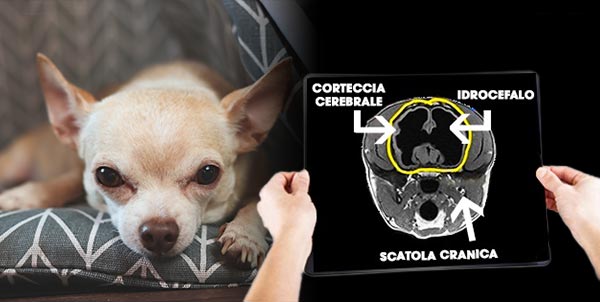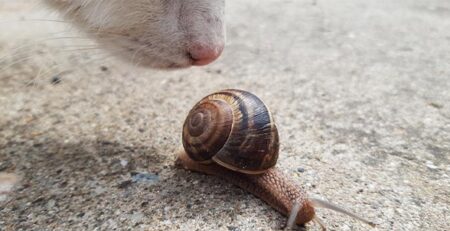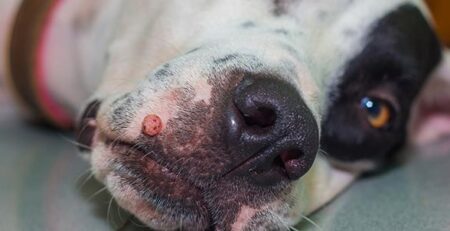Table of Contents
Hydrocephaly in dogs is a condition caused by blocked flow or reabsorption of cerebrospinal fluid within the brain resulting in accumulation in the ventricular cavities.
Blockage can occur as a result of obstruction in drainage or abnormal increase in production.
Hydrocephaly in the dog can be distinguished into:
-Congenital when it occurs in the first weeks of the animal’s life.
Symptomatology varies greatly depending on the severity of compression.
It is the most common condition.
or
-Acquired if onset occurs as a result of head trauma, brain hemorrhage, vitamin A deficiency, brain neoplasms, chemicals, bacteria, viruses, or other toxins.
This, however, is an occasional condition.
How is hydrocephalus classified?
There are two variations:
– compensatory or communicating when CSF is produced in higher than average amounts and accumulates in the ventricles, which then tend to dilate.
or
– obstructive or noncommunicating when normal cerebrospinal fluid flow is blocked by an actual physical obstruction.
What are the most obvious symptoms of hydrocephaly?
Increased intracranial pressure causes a clearly visible deformation of the cranial bones in young dogs.
Significantly, this is why the skull takes on that anomalous and characteristic “dome” shape.
And again, often the cranial bones do not fuse, leaving a space covered only by skin and subcutis: this is the so-called “fontanelle.”
Then, to this are added:
- Visual impairments (partial/full blindness, strabismus)
- breathing difficulties
- disorientation
- lethargy
- convulsive seizures
- Progressive loss of muscle coordination
- Behavioral changes (aggression, hyperexcitability)
- Compulsive attitudes (vocalizing, tail chasing, circling)
Are there breeds at greater risk of hydrocephaly?
As is well known, most dogs affected by hydrocephalus are those with round heads and short, broad snouts.
Basically, these are the brachycephalic dogs.
Overall, there would seem to be a close correlation between hydrocephaly and brachycephaly.
However, brachycephalic dwarf breeds are the most susceptible:
- Chihuahua, by far the most affected
- Yorkshire Terrier
- Spitz
- Poodle
- Volpino
- Pinscher
- Cavalier King
- Maltese
- Pekingese
- Pug
In addition to genetic predisposition, there are also risk factors that may be associated with hydrocephaly.
Last but not least, the small size of puppies at birth, possible difficult or stressful delivery, and premature birth also affect.
Diagnosis and prognosis of hydrocephalus
First of all, in order to reach a definitive diagnosis, imaging must be used: x-rays, ultrasound, CT scans, MRI.
Be that as it may, the prognosis is variable and depends mainly on the extent of symptoms, the brain damage caused, and whether or not intervention can be taken to reduce intracranial pressure.
The drug treatment for hydrocephalus dog
In cases of diagnosed presence of hydrocephalus in dogs, drug treatment is primarily aimed at reducing the amount of CSF produced.
Unfortunately, however, drug-only therapy, in most cases, brings temporary improvement.
Surgery for hydrocephalus
Although rarely, surgical treatment, the Ventriculo-Peritoneal Shunt, may be evaluated.
Basically, it consists of applying an external drain from the encephalon to the dog’s abdomen.
To put it briefly, drainage aims to channel and make excess fluid flow elsewhere.
By doing so, the enlarged ventricles return to their normal size.
Regardless, it is a very complex surgery that is used in extreme cases and can create postoperative complications.
Mechanical malfunction or infection, for example, are among the most common.
Early diagnosis and therapeutic treatments are crucial
Because hydrocephaly is often a congenital condition, the importance of medical checkups at birth becomes apparent.
Contact us for a consultation: only early diagnosis can avoid the tragic consequences and improve, as much as possible, the quality of life of dogs affected by this terrible disease.
In this regard, we would like to remind you that Clinica La Veterinaria is always open daily h24 including holidays and with First Aid service from 8 pm to 8 am.
For the joy of seeing them HAPPY.











